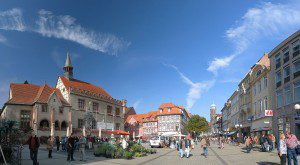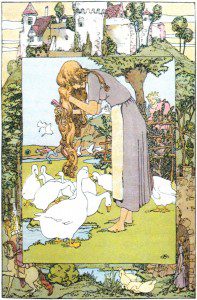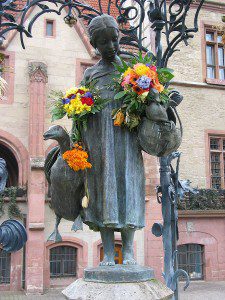
Photo by Daniel Schwen
(Click to enlarge. Click again to enlarge further.)
We drove up this morning from Frankfurt to the university town of Göttingen, in Lower Saxony.
I haven’t been here in, I believe, forty two years. (Yes, I’m that old.)
We walked around the Innenstadt, the inner city (within the old walls). It was very pleasant, because today was a holiday, “das Fronleichnamsfest” (Latin: Sollemnitas Sanctissimi Corporis et Sanguinis Christi or, even, Corpus Christi), which is a Catholic festival celebrating the “real presence” of the body and blood of the Savior in the consecrated elements of the mass. Anyway, there was little or no traffic, and there were very few people even in the extensive pedestrian zones.

(Click on the image to enlarge it. Click again to enlarge it further.)
The Göttinger Innenstadt is a charming place, with several late medieval churches and a lot of domestic and other secular architecture dating to the 1500s through the early 1800s. We ate in a noodle house in one of those old buildings, and I had the obligatory schnitzel. After all, if I’m going to be back in German-speaking Europe, I need to get right down to the essentials.

Photo by Daniel Schwen
(Click to enlarge. Click again to enlarge further.)
We went to look at the famous statue of the “goose girl” — or, as she’s known here, “Gänseliesel” or “Goose Liesel.” She’s based on the fairy tale of that name that was included in the stories collected by the Brothers Grimm, who taught here at the University and served as its librarians. (They were professional linguists and philologists — Jakob is known for “Grimm’s Law” — and they saw themselves as gathering anthropological and linguistic-historical material, not children’s stories. In fact, many of the tales they collected were emphatically not intended for children. They can be quite gruesome, for one thing.)
When students receive their doctorates from the University here, custom has them ride through the old city in a handcart and then climb up, offer a bouquet of flowers to “Gänseliesel,” and kiss her. She’s said to be the most-kissed girl in the world.
I regret that we had no such customs when I received my doctorate. Ii we had, I might have attended my graduation ceremonies.
However, I especially enjoyed seeing little plaques on many of the buildings, telling who had lived in them either as students or, sometimes, as faculty. As a list of those historically associated with the city’s Georg-August Universität will show, Göttingen has played an extremely important role in Germanic culture and in the history of mathematics and science.
I mentioned above that I was last here about forty two years ago. And it was only for maybe two nights.
It’s one of my favorite stories from my mission, so I’m going to record it here.
One of our missionaries in Switzerland was a German-American whose grandmother lived in Göttingen with his aunt and uncle. His parents, told that the grandmother was dying, somehow obtained permission for him to travel from Switzerland up to northern Germany in order to say goodbye to her on behalf of the American part of the family. Of course, under Church missionary rules, he would need someone to go with him. So, for some reason, although I wasn’t the elder’s companion, my mission president called me up and asked if I would accompany him to northern Germany.
We traveled by overnight train and, truth be told, I don’t remember the trip very well. Except that we were both surprised at how vigorous, lively, and energetic his grandmother was. I wish I remembered her name; she’s probably still alive.
But I do remember well an encounter on the Marktplatz, the market place or market square of the Innenstadt.
It was a Saturday, and the square was very crowded. To our delight, we saw a pair of fellow missionaries doing “street contacting” there.
In those days, at least in Switzerland, we didn’t wear missionary name tags. (I don’t think that the two Göttingen missionaries had them, either. But I could be wrong.)
Anyway, one of the two missionaries approached me, offered me a copy of the pamphlet “Joseph Smith Tells His Own Story,” and asked “Möchten Sie eine?” (“Would you like one?”)
I pulled a copy of the same pamphlet out of my own suit coat pocket and asked “Möchten Sie eine?” (“Would you like one?”)
“Who are you?” he asked, visibly surprised.
“I’m Brother Peterson,” I replied, “of the Swiss Mission.”
“Oh,” he responded. “You’re on your way home.”
“No,” I said, quite truthfully. “I have another year to go.”
He was obviously baffled, so I offered an explanation:
“You see,” I told him, “baptisms are so rare in Switzerland that, when we get one, we’re given an award. I’ve already been southwards, into Italy and Greece, so, this time, I thought I’d come northwards.”
“You’re kidding!” he exclaimed.
I dunno. Sometimes the Devil just gets into me. I can’t account for it.
But I only let him ponder what I’d just told him for about thirty seconds or so, and then, my conscience having kicked in, I told him the truth.
Posted from Göttingen, Germany










